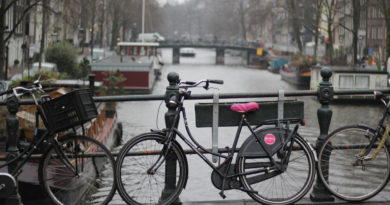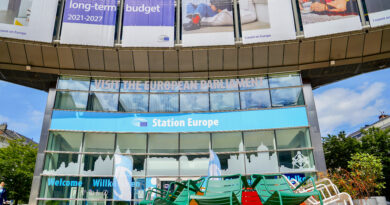‘Settled status’ fee scrapped as residence scheme for EU nationals opens
EU nationals living in the UK will no longer have to pay for the right to stay in the country after Brexit. Prime Minister Theresa May announced today that the ‘settled status’ fee will be waived.
“A number of members have made powerful representations about the anxiety of EU citizens in the UK and UK citizens in the EU who are waiting to have their status confirmed,” Theresa May said in parliament.
“Having listened to concerns from members and organisations like the3million group, I can confirm today that when we roll out the scheme in full on 30 March, the government will waive the application fee so that there is no financial barrier for any EU nationals who wish to stay. Anyone who has applied or will apply during the pilot phase will have their fee reimbursed. And more details on how this will work will be made available in due course.”
Members of parliament across parties, the Mayor of London and advocacy groups had called on the government to offer ‘settled status’ free of charge. They considered asking people to pay to stay at home unfair. The fee would have also been a financial burden for the most vulnerable. Many companies had announced they would cover the cost of the application for their EU staff.
James O'Brien on the "settled status" process: "We're asking people to provide their papers in order to pay for the privilege of living at home. I never thought I'd live in a country like this."@mrjamesob | #Brexit pic.twitter.com/KYe0LCkxwc
— LBC (@LBC) January 21, 2019
What is the “settled status” scheme
EU nationals can live, study and work in the UK on the basis of EU’s free movement rules that will no longer apply after Brexit. The settled status (or ‘EU settlement’) scheme has been designed to replace the EU’s permanent residence system.
The scheme is part of the agreement on the UK withdrawal from the EU. The British government has confirmed it will be rolled out also in the event of a no deal Brexit. All EU nationals living in the UK will have to apply by 30 June 2021, or 31 December 2020 in case of no deal.
With settled status, they will maintain almost all existing rights, such as access to employment, healthcare, social security and other benefits. The cost of the application was set at 65GBP for adults and 32.5GBP for under 16s.
How it works
The criteria to apply for ‘settled status’ are: being a citizen of another EU country, having lived continuously in the UK for five years and not having serious criminal records. EU nationals who have lived in the UK for less than five years can obtain pre-settled status and complete the five-year requirement.
People who already have a permanent residence card or an ‘indefinite leave to remain’ document, will be able to swap them with settled status.
The Home Office has commissioned an app, “EU Exit: ID Document Check”, which allows to apply and verify the identity remotely. The app is only available on Android smartphones or tablets using NFC (Near-Field Communication) protocols. Applicants without access to these devices will be able to apply by post when the scheme fully opens on 30 March 2019.
The Home Office will cross-check the data provided by the applicant with the records at the Department for Work and Pensions (DWP) and HM Revenue and Customs (HMRC). Those who cannot prove their residence in this way can provide other documents as evidence (e.g. bills and bank statements).
Once the procedure is completed, confirmation of ‘settled status’ is provided in digital form.
The Home Office promises to help applicants avoid errors or provide additional information if needed. Only people with serious criminal records will be denied the status, it has been said.
The UK intends to use the same system for citizens of Iceland, Liechtenstein and Norway and Switzerland, who are currently covered by EU rules too. Irish nationals do not have to apply, as free movement in the UK will continue under the Common Travel Area, which existed before the two countries joined the EU.
When to apply
A public test phase starts on a voluntary basis on 21 January 2019. The test is open to EU nationals living in the UK who have a valid EU passport. Non-EU family members of EU citizens with a biometric residence card can also apply at this stage.
For everyone else, including citizens of Iceland, Liechtenstein, Norway and Switzerland, the scheme will open in full by 30 March 2019.
Controversy
The settled status scheme has created controversy on a number of issues besides the fee.
First, everyone applying has to accept a privacy policy allowing the government to share data with “public and private sector organisations in the UK and overseas”. The Home Office has refused to disclose how these data may be used.
Second, a clause in the Data Protection Act 2018 allows state bodies and other organisations to use people’s data without them being aware nor having access to it, for “effective immigration control”. Campaigners are taking the government to court over this issue, which could prevent people from defending their rights.
Finally, permanent residence was an acquired right, while settled status involves an application and raises the prospect of possible rejections.
There are also concerns about the sheer number of applications the Home Office will have to process in a short time. To confirm the rights of some 3.5 million EU nationals by the deadline of 31 December 2020, the Home Office will have to deal with some 5,500 applications a day.
During the testing phase from November 1 to December 21, which targeted EU staff in the academic and healthcare sectors, 29,987 people applied (588 per day). By January 14, 27,211 had obtained settled status. Of the 2,776 pending cases (9% of the total), the majority required verification of the identity or contained errors, according to a report by the Home Office. About a third were awaiting for further evidence or clarifications.
On the basis of the tests, the Home Office is improving the guidelines and ensuring technical adjustments that should make the process easier.
Claudia Delpero © all rights reserved.
Photo via Pixabay.





